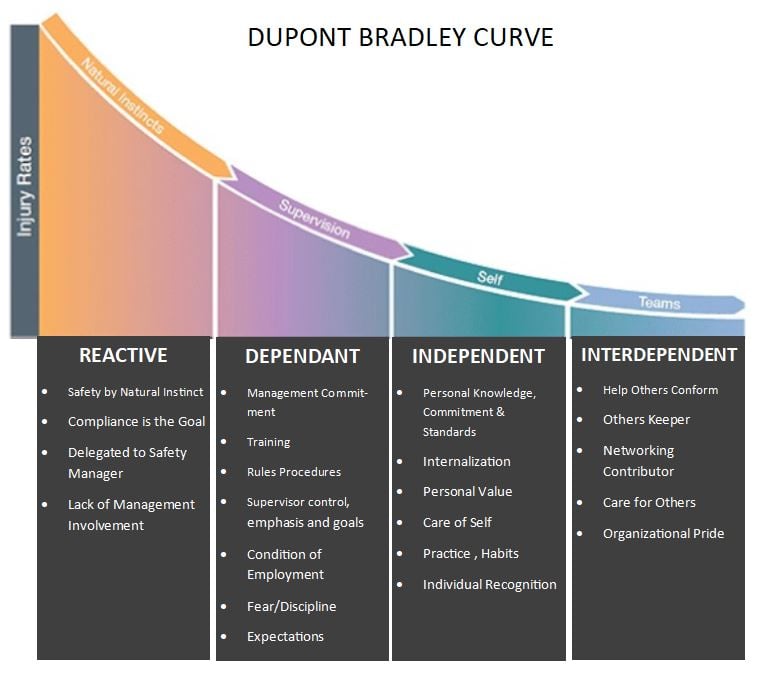As a safety director, manager, or business owner, do you often feel that it's you against the employees when it comes to safety? Do you want your employees to feel ownership and responsibility for not just their safety, but for everyone else's?
This is where the DuPont Bradley Curve is helpful. It's a tool to help businesses shift their employees from following safety protocol because it's what is required, to a place where everyone from the top down is actively participating in the safety culture of the organization. Obviously, anytime someone is practicing safety is a positive, but it's even better if people are following protocol because they have a genuine desire to keep themselves and their coworkers safe.

The DuPont Bradley Curve provides an illustration on how agribusiness can achieve a safety culture that isn't based on compliance (rules and regulations), but rather a commitment to get everyone home safe.
REACTIVE
The first stage is the reactive stage, which is never proactive about safety, and typically safety measures happen in reaction to accidents or injuries. Employees may or may not follow proper procedures because in this stage, decisions about safety are based on however the employee is feeling in the moment. There is a lack of communication between managers and employees, and no one at any level is really taking responsibility to make sure everyone stays safe. This stage has the highest level of injuries and accidents and quality and performance are at the lowest.
DEPENDENT
The next stage is the dependent stage. In this stage, the management is committed to safety, but the employees are only following protocol because of the rules, not because they're invested in their safety. Employees are being trained and policies are in place, but will only follow procedures part of the time or if they're reminded by management. Safety is completely based on compliance during this stage, and while the rate of accidents lessens from the reactive stage, there is still a lot of room for growth.
INDEPENDENT
Moving to the right, the independent stage comes next. This is where we begin shifting the thinking of the employees and business overall. It's called the independent stage because employees are taking responsibility for their own safety, rather than doing something because management told them to. Equipment is operated properly and risky behavior is curbed as people begin calculating the potential consequences for their actions and taking ownership of their performance. Individuals are taking steps to make sure they end each day without accident or injury. Quality and production rise and there is a large reduction in injuries and accidents.
INTERDEPENDENT
The final phase of this model is the interdependent stage. While the independent stage was close to what we want in safety, this last component has employees not just looking out for themselves, but for everyone around them. To have a business that is truly committed to safety, we need each other. Our collective actions impact the safety of our workplace, which is why this final stage is so important. In this phase, there is a team mentality, a shared sense of pride in the work, and a serious commitment from everyone to zero incidents. Employees hold each other accountable and there is open communication about the risks they face and how to keep improving safety. The number of accidents and injuries is very low and productivity is high. This is where a culture of safety, rather than a safety program, is possible.
Final Thoughts
The DuPont Bradley Curve can be an incredibly useful tool for evaluating where your business is at when it comes to safety. It demonstrates how important it is to prioritize safety, because when we do, not only are we keeping people safe, but we're strengthening our business and increasing our profitability. It's time to make the switch from compliance to commitment so that everyone can Get Home Safe.


